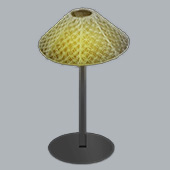Design Resource
Natural Fibre Lamp Shade - Alleppey, Kerala
Eco-friendly Lamp Shade
by
Prof. Bibhudutta Baral and Ranjitha M. C.
Natural fibres are hair-like raw materials that are continuous filaments like pieces of thread. There are two types of fibres: natural fibres and synthetic fibres. These natural fibres can be spun into filaments, threads or ropes. Nowadays these natural fibres are being used in the textiles, building, plastics and automotive industries. Natural fibres are further classified according to their sources like vegetable fibres, animal fibres and mineral fibres. In vegetable fibres, cellulose is the main component, whereas these fibres are further classified into the following types,
• Seed fibres - These are the fibres from seeds or seed cases for example cotton and kapok.
• Leaf fibres - These fibres are collected from leaves, for example- sisal and agave.
• Bast fibre or skin fibre - These are fibres which are collected from the skin or bast surrounding the stem of plant source. These fibres have higher tensile strength than other fibres. Hence these fibres are used for durable yarn, fabric, packaging and paper. For examples flax, jute, kenaf, industrial hemp, ramie, rattan, soybean fibre and even vine fibres and banana fibres.
• Fruit fibres - These fibres are collected from the fruit of the plants.
• Stalk fibres - These fibres are really the stalks of the plants like straws of wheat, rice, barley and other crops including bamboo and grass.
In 19th century, the use of natural fibres significantly decreased and there was a massive rise in the production of synthetic fibres. Whereas now the situation has especially due to the environmental concern in favour of natural fibres as they are biodegradable and sustainable materials. India has huge resources of natural fibres like banana, khus, sisal, korai grass, talipot, palm leaf, coconut, pineapple, screw pine, golden grass, jute, sabai etc. The rural artisans converted these fibres into value-added finished products like bags, table mats, cushion covers, hats, floor coverings and lampshades etc., which provides large employment to the rural poor, especially the underprivileged class.
Lampshades are one of the earliest discoveries of man-made lighting. In the early 17th century, Paris streets were lit with oil lamps that were fit with reflectors above and alongside in which the flame projected the light downward and from side to side. Then those oil lamps were followed by gas lights and were filtered by opal glass or shades with fabric stretched on a wireframe but the drawback of these gaslighting was overheating of air and high oxygen consumption which pollute the environment.




